Asparagus
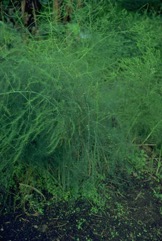
It is a temperate or Mediterranean plant. It needs a temperature of 16-24°C for good growth. It needs a lower temperature for 60-100 days when the plants are dormant. In Papua New Guinea it is grown mainly in the highlands at over 1000 m altitude in the tropics. It grows up to 2600 m. It can be grown on the tropical coast with special management. It prefers humus rich, moist, well drained soils. It does best in an open sunny position. It is frost resistant but drought tender. A pH of 6-6.8 is suitable. In China it grows naturally on the steppes in NW Xinjiang. It suits hardiness zones 4-8.
Also known as:
Ayrelli, Esparrago, Halyum, Hillua, Kannyut, Katsitsimzukwa, Nag-down, Shi diao bai, Sotomool, Sparanghel, Sparoga
Synonyms
- Asparagus longifolius Fisch. ex Steud
- Asparagus officinalis var. altilis L.
- Asparagus polyphyllus Steven
Edible Portion
- Leaves, Shoots, Vegetable, Roots, Seeds - coffee, Vegetable
Where does Asparagus grow?
Found in: Africa, Albania, Argentina, Armenia, Asia, Australia, Austria, Azerbaijan, Balkans, Belgium, Bosnia, Britain, Bulgaria, Cambodia, Canada, Caucasus, Central America, Central Asia, China, Croatia, Cuba, Cyprus, Czech Republic, Denmark, Dominican Republic, East Africa, Egypt, Europe, France, Georgia, Germany, Greece, Guam, Haiti, Hawaii, Hungary, India, Indochina, Indonesia, Iran, Ireland, Italy, Kazakhstan, Kenya, Korea, Laos, Luxembourg, Macedonia, Malawi, Malaysia, Mediterranean, Moldova, Mongolia, Myanmar, Netherlands, North Africa, North America, Northeastern India, Pacific, Pakistan, Papua New Guinea, PNG, Philippines, Poland, Portugal, Puerto Rico, Romania, Russia, Sao Tome and Principe, SE Asia, Serbia, Siberia, Slovenia, Solomon Islands, South Africa, Southern Africa, South America, Spain, Switzerland, Tasmania, Thailand, Turkey, Tuvalu, United States, Uzbekistan, Vietnam, West Indies, Yugoslavia
Notes: There are between 160-300 Asparagus species.
Status: It is a commercially cultivated vegetable. Not widely grown in Papua New Guinea and then mostly near the houses of Europeans.
Growing Asparagus
Cultivation: Plants can be grown from seed. It is best to soak the seeds for 24 hours then sow them in a nursery. They are transplanted after 8-12 months. A spacing or 1 m x 1 m is suitable. If white shoots are required, the shoots need to be kept covered with soil. Shoots turn green in sunlight. Plants can also be grown by division of the clump. These are planted 15 cm deep. For seed production a male plant is needed for each 4 female plants. Bees help pollination.
Edible Uses: The young shoots are eaten cooked. They should only be washed just before cooking. The tuberous roots of some wild asparagus plants are eaten in China. Young roots should be used. The seeds have been used as a substitute for coffee.
Production: The first harvest is 18-24 months after planting. The shoots are cut before they open out into the ferny erect stems. They are cut below ground level when about 15-20 cm high.
Nutrition Info
per 100g edible portion| Edible Part | Energy (kcal) | Protein (g) | Iron (mg) | Vitamin A (ug) | Vitamin c (mg) | Zinc (mg) | % Water |
|---|---|---|---|---|---|---|---|
| Stalk - boiled | 12 | 1.7 | 0.6 | 50 | 16 | 0.3 | 95.4 |
| Stalk - raw | 17 | 1.9 | 1 | 58 | 21 | 0.5 | 93.6 |
| Roots | - | - | - | - | - | - | |
| Seeds - coffee | - | - | - | - | - | - |
Asparagus Photos

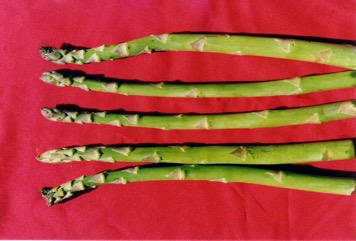
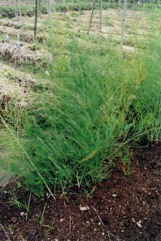
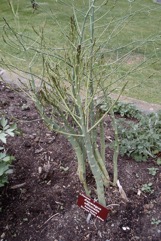
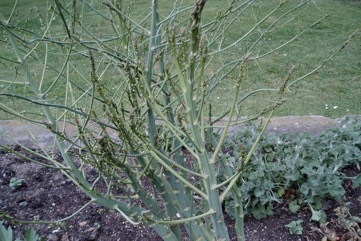
References
Aberoumand, A. and Deokule, S. S., 2009, Determination of Elements Profile of Some Wild Edible Plants. Food Anal. Methods. 2:116-119
Ali, H., et al, 2011, Ethnobotanical profile of some plant resources in Malam Jabba valley of Swat, Pakistan. Journal of Medicinal Plants Research Vol. 5(18), pp 4676-4687
Ambasta S.P. (Ed.), 2000, The Useful Plants of India. CSIR India. p 59
Barua, U., et al, 2007, Wild edible plants of Majuli island and Darrang districts of Assam. Indian Journal of Traditional Knowledge 6(1) pp 191-194
Beckstrom-Sternberg, Stephen M., and James A. Duke. "The Foodplant Database." http://probe.nalusda.gov:8300/cgi-bin/browse/foodplantdb.(ACEDB version 4.0 - data version July 1994)
Bianchini, F., Corbetta, F., and Pistoia, M., 1975, Fruits of the Earth. Cassell. p 88
Bircher, A. G. & Bircher, W. H., 2000, Encyclopedia of Fruit Trees and Edible Flowering Plants in Egypt and the Subtropics. AUC Press. p 45
Blamey, M and Grey-Wilson, C., 2005, Wild flowers of the Mediterranean. A & C Black London. p 484
Bodkin, F., 1991, Encyclopedia Botanica. Cornstalk publishing, p 108
Brown, D., 2002, The Royal Horticultural Society encyclopedia of Herbs and their uses. DK Books. p 134
Cerne, M., 1992, Wild Plants from Slovenia used as Vegetables. Acta Horticulturae 318.
Cheifetz, A., (ed), 1999, 500 popular vegetables, herbs, fruits and nuts for Australian Gardeners. Random House p 35
Chen Xinqi, Liang Songyun, Xu Jiemei, Tamura M.N., Liliaceae. Flora of China. p 145
Chin, H. F., 1999, Malaysian Vegetables in Colour. Tropical Press. p 64
Ciftcioglu, C. G., 2015, Sustainable wild-collection of medicinal and edible plants in Lefke region of North Cyprus. Agroforest Syst. Springer
Ciocarlan, N. & Ghendov, V., 2015, Ethnobotanical and Ecological Studies of Wild Edible Plants from Bugeac Steppe, Republic of Moldova. Journal of EcoAgriTourism. Cailta terra Vol. 11(2):
Cundall, P., (ed.), 2004, Gardening Australia: flora: the gardener's bible. ABC Books. p 196
Curtis, W.M., & Morris, D.I., 1994, The Student's Flora of Tasmania. Part 4B St David's Park Publishing, Tasmania, p 370
Ekman Herbarium records Haiti
Ertug, F, Yenen Bitkiler. Resimli Türkiye Florası -I- Flora of Turkey - Ethnobotany supplement
Esperanca, M. J., 1988. Surviving in the wild. A glance at the wild plants and their uses. Vol. 1. p 69
Facciola, S., 1998, Cornucopia 2: a Source Book of Edible Plants. Kampong Publications, p 32
Flora of China. www.eFloras.org
Foo, J.T.S.(ed), 1996, A Guide to Common Vegetables. Singapore Science Foundation. p 113
French, B., 1986, Food Plants of Papua New Guinea, Asia Pacific Science Foundation p 131
French, B.R., 2010, Food Plants of Solomon Islands. A Compendium. Food Plants International Inc. p 152
Grubben, G. J. H. and Denton, O. A. (eds), 2004, Plant Resources of Tropical Africa 2. Vegetables. PROTA, Wageningen, Netherlands. p 95
Hadfield, J., 2001, The A-Z of Vegetable Gardening in South Africa. Struik p 74
Hedrick, U.P., 1919, (Ed.), Sturtevant's edible plants of the world. p 80
Hu, Shiu-ying, 2005, Food Plants of China. The Chinese University Press. p 316
Irving, M., 2009, The Forager Handbook, A Guide to the Edible Plants of Britain. Ebury Press p 339
Jardin, C., 1970, List of Foods Used In Africa, FAO Nutrition Information Document Series No 2.p 57
Kays, S. J., and Dias, J. C. S., 1995, Common Names of Commercially Cultivated Vegetables of the World in 15 languages. Economic Botany, Vol. 49, No. 2, pp. 115-152
Kiple, K.F. & Ornelas, K.C., (eds), 2000, The Cambridge World History of Food. CUP p 1723
Lazarides, M. & Hince, B., 1993, Handbook of Economic Plants of Australia, CSIRO. p 27
Low, T., 1992, Bush Tucker. Australia’s Wild Food Harvest. Angus & Robertson. p 156
Luczaj et al, 2013, Wild vegetable mixes sold in the markets of Dalmatia (southern Croatia). Journal of Ethnobiology and Ethnomedicine. 8:2
Mabey, R., 1973, Food for Free. A Guide to the edible wild plants of Britain, Collins. p 115
MacKinnon, A., et al, 2009, Edible & Medicinal Plants of Canada. Lone Pine. p 174
Macmillan, H.F. (Revised Barlow, H.S., et al), 1991, Tropical Planting and Gardening. Sixth edition. Malayan Nature Society. Kuala Lumpur. p 359
Martin, F.W. & Ruberte, R.M., 1979, Edible Leaves of the Tropics. Antillian College Press, Mayaguez, Puerto Rico. p 202
Miguel, E., et al, 1989, A checklist of the cultivated plants of Cuba. Kulturpflanze 37. 1989, 211-357
Norrington, L., & Campbell, C., 2001, Tropical Food Gardens. Bloomings Books. p 24
Ochse, J.J. et al, 1931, Vegetables of the Dutch East Indies. Asher reprint. p 457
Paczkowska, G. & Chapman, A.R., 2000, The Western Australian Flora. A Descriptive Catalogue. Western Australian Herbarium. p 37
Plants of Haiti Smithsonian Institute http://botany.si.edu
Redzic, S. J., 2006, Wild Edible Plants and their Traditional Use in the Human Nutrition in Bosnia-Herzegovina. Ecology of Food and Nutrition, 45:189-232
Ruiters-Welcome, A. K., 2019, Food plants of southern Africa. Ph.D. thesis. Univ. of Johannesburg p 30
Schneider, E., 2001, Vegetables from Amaranth to Zucchini: The essential reference. HarperCollins. p 26
Sharma, B.B., 2005, Growing fruits and vegetables. Publications Division. Ministry of Information and broadcasting. India. p 203
Siemonsma, J. S. and Piluek, K. (Eds), 1994, Plant Resources of South-East Asia No. 8 Vegetables. Prosea Foundation, Bogor, Indonesia, p 91
Simkova, K. et al, 2014, Ethnobotanical review of wild edible plants used in the Czech Republic. Journal of Applied Botany and Food Quality 88, 49-67
Smith, P.M., 1979, Asparagus, in Simmonds, N.W., (ed), Crop Plant Evolution. Longmans. London. p 315
Sp. pl. 1:313. 1753
Staples, G.W. and Herbst, D.R., 2005, A tropical Garden Flora. Bishop Museum Press, Honolulu, Hawaii. p 682
Stone, B. C., 1970, The Flora of Guam. A Manual for the Identification of the Vascular Plants of the Island. Micronesica. Journal of the University of Guam. p 115
Tardio, J., et al, 2006, Ethnobotanical review of wild edible plants in Spain. Botanical J. Linnean Soc. 152, 27-71
Tasmanian Herbarium Vascular Plants list p 68
Terra, G.J.A., 1973, Tropical Vegetables. Communication 54e Royal Tropical Institute, Amsterdam, p 26
Thaman, R. R, 2016, The flora of Tuvalu. Atoll Research Bulletin No. 611. Smithsonian Institute p 48
Tindall, H.D., 1983, Vegetables in the Tropics, Macmillan p 322
USDA, ARS, National Genetic Resources Program. Germplasm Resources Information Network - (GRIN). [Online Database] National Germplasm Resources Laboratory, Beltsville, Maryland. Available: www.ars-grin.gov/cgi-bin/npgs/html/econ.pl (10 April 2000)
van Wyk, B., 2005, Food Plants of the World. An illustrated guide. Timber press. p 78
Williamson, J., 2005, Useful Plants of Malawi. 3rd. Edition. Mdadzi Book Trust. p 31
World Checklist of Useful Plant Species 2020. Royal Botanic Gardens, Kew